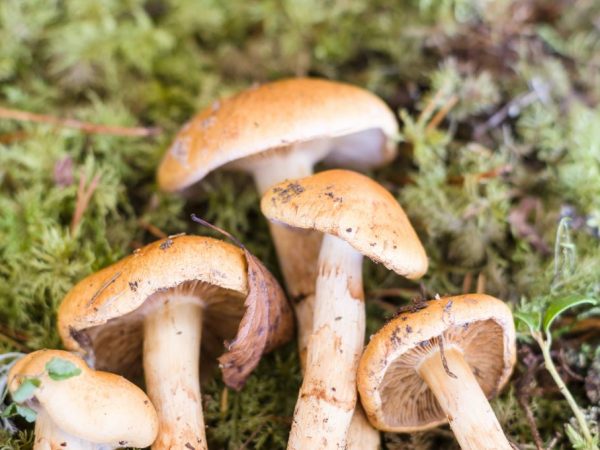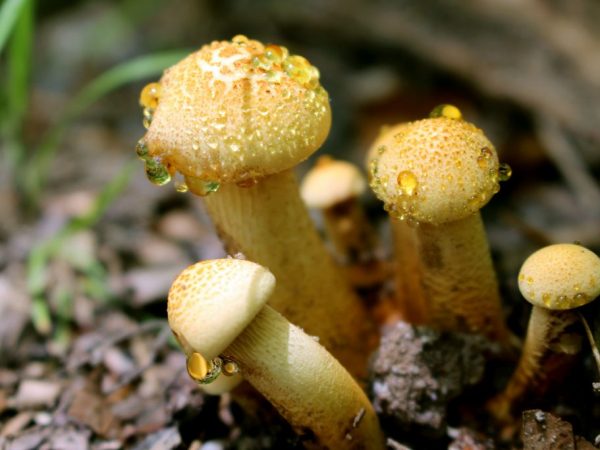Description of yellow mushroom
Many people like to go mushroom picking. The yellow mushroom is very popular with mushroom pickers. He is loved for its appearance and pleasant smell. It is used in cooking and healing.

Description of yellow mushroom
Description of the mushroom
The yellow mushroom is edible, it grows on trees and is noticeable due to its bright colors. His red cap has an orange tint around the edges. The organism is placed on the trunks in small groups. It does not have the usual thick leg, the bottom of the cap is black, and the cut point gradually turns blue. The leg is brown.
Sometimes the leg is white with pink-red spots. Over time, the base takes on a gray tint. Only young specimens are eaten because toxins accumulate in old ones with age and fungi become inedible.
Description of the yellow mushroom:
- height - 5-6 cm, width - up to 15-20 cm;
- yellow-brown hymenophore darkens with age;
- ellipsoidal spores.
Semicircular fruit bodies are small and fleshy.
Depending on the degree of ripening, the color of the mushroom changes. In the young, it is orange-brown, inside it has a red-pink tint, the cap on top is bilious. They use a red-brown organism, the thick leg of which has a gray tint. Grows in deciduous trees. Often found on birch and alder.
Views
There are two types of yellow mushroom:
- Hericium yellow: has a fruity aroma, dense flesh. The hat is brown at the top and white at the bottom, rough, irregular in shape, the cut gradually becomes blue. The leg at the base is black.
- The webcap is yellow: it has a smooth cap, it is orange-yellow in the center, slippery on top, pink-white inside, the cut becomes blue. It is characterized by a thick black leg, has a delicate taste, and is often used for pickling.
Irina Selyutina (Biologist):
Hericium yellow belongs to edible mushrooms, however, due to the incomprehensible type of hymenophore, it is prickly in the mushroom, it is very often considered inedible. His cap is often irregular in shape and tends to grow together with the caps of a number of growing mushrooms from the family. The cuticle (skin) does not separate from the surface of the cap. Hericium yellow is often confused with the common chanterelle.
All mushrooms of this peculiar group have some similarities, namely, a bright yellow cap and delicate flesh. Poisonous yellow mushrooms are sometimes found. They are distinguished by a brighter yellow-red color, a gray leg and a pungent smell of chlorine and rot, the cut of the pulp quickly acquires a green tint.
Beneficial features
This red-yellow mushroom has a number of beneficial properties. It contains a lot of amino acids and vitamins that are so necessary for the body.
The nutritional value:
- water - 83.5;
- fatty acids - 0.53;
- unsaturated fatty acids - 0.42;
- dietary fiber - 4.22;
- ash - 0.83;
- mono- and disaccharides - 1.15.
The beneficial substances in its composition strengthen the immune system, have a positive effect on the skin and hair. Vitamins A, D and group B relieve fatigue, this mushroom is especially useful for people who are often stressed.

Mushroom helps manage stress
Contraindications
Overripe yellow individuals and mushrooms with a green tint should not be eaten. They accumulate a lot of toxic substances that can cause serious poisoning.
Before cooking, the collected young specimens are thoroughly washed under running water. It is necessary to boil for 10-15 minutes, and then the water is drained.
Application
Jaundice is often used in cooking. When cooked, it takes on the pleasant smell of fried chicken. It is also dried and pickled.
The species is widely used in medicine. Tinctures are prepared from it, which increase immunity, and also heal the stomach and heart.
In cooking
This mushroom is edible and tastes good. Used when preparing first and second courses. It is often eaten fried. To prepare this dish, take:
- mushrooms - 350 g;
- sour cream - 1 glass;
- onions - 100 g;
- butter;
- salt, spices.
Finely chop the onion and fry in oil, then add chopped mushrooms, spices and salt. Then pour in sour cream and stew for 5-7 minutes. This dish is used as a sauce.
The yellow mushroom is also often dried for the winter. It is washed, dried, cut into large pieces and strung on a thread. Avoid exposure to direct sunlight, dry in a well-ventilated room. A distance of about 1 cm should remain between the pieces. With this drying method, it is best to cover the mushrooms with gauze to prevent insects from "visiting" the workpiece.
At home, the orange mushroom is dried in the oven. It is cleaned, cut into slices and carefully laid out on a wire rack or on a tray covered with culinary parchment. It is important that the mushrooms are loose. The temperature should first be no higher than 40-45 ° C. When the plates wilt and stop sticking to the parchment dry, the temperature is raised to 75-80 ° C and left to dry completely. Also, during drying, do not close the oven door tightly. This is necessary for good ventilation.
In medicine
Regular use of this product strengthens the immune system. It is especially useful to eat it during the rehabilitation period.
An extract of jaundice is used to treat skin diseases. If you regularly wipe problem areas with a solution, the rash will quickly disappear. Wounds are treated with dried mushroom powder. Sprinkle them 3-4 times a day until they are completely healed.
To improve overall health, a tincture is prepared:
- dried mushrooms are ground;
- add 50 ml of alcohol or vodka and honey;
- insist 3 days in the refrigerator.
This medicine is taken 2 times a day 30 minutes before meals. They also treat varicose veins. Fresh mushrooms are poured into 1 liter of alcohol and infused for 1.5-2 weeks. Sore areas are lubricated 4-5 times a day. The course of treatment lasts 2 months.
Conclusion
Young mushroom, yellow in color - edible and has beneficial properties, is used in cooking and medicine. It can be found in green deciduous forests and will grow on the bark of trees.
Most often, this type is consumed fried or pickled. In medicine, they are used to increase the protective properties of the body and treat certain diseases.



